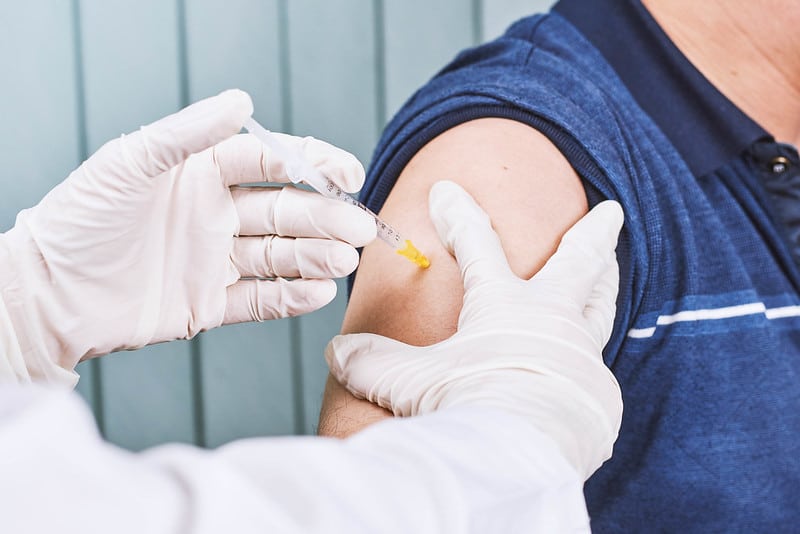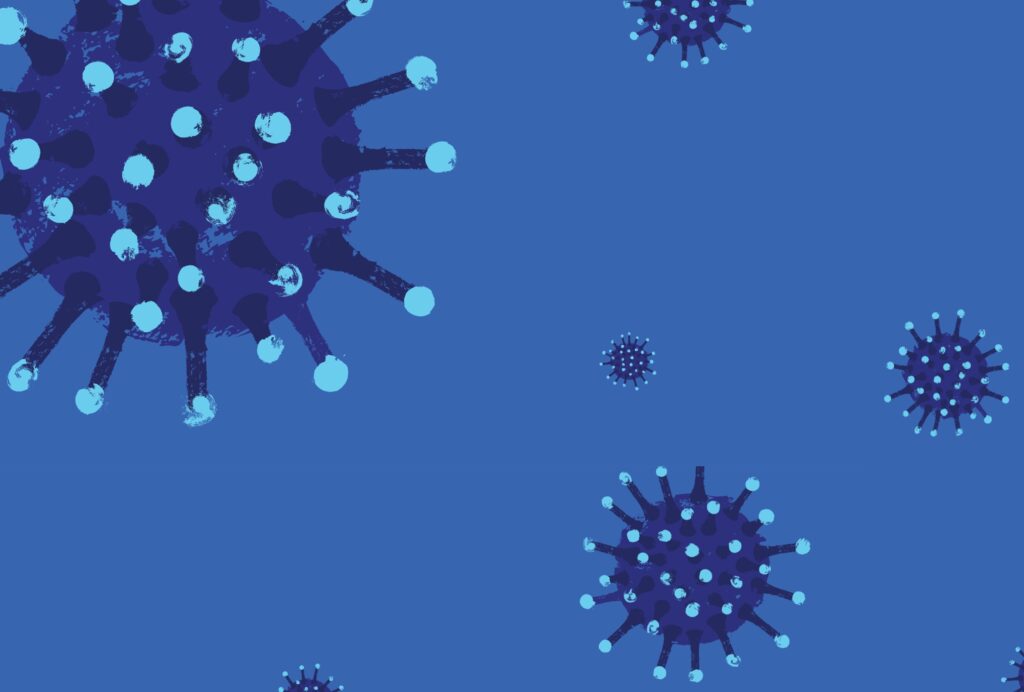Widespread vaccination is generally regarded as the primary exit route out of the COVID-19 crisis, and for good reason. Even as we continue our collective struggle against the delta variant, we consistently observe reduced infections, morbidity, and mortality in fully vaccinated people living in nations fortunate enough to have supply and access to these products. This was a promise made after the highly anticipated publication of Phase 2/3 trials as a truly torrid 2020 drew to a close. That promise is now being delivered on for billions of people.
From my perspective and experience as an immunologist working in drug discovery, this was a glimpse of light at the end of the tunnel: the development of essential tools needed to rein in the global spread of SARS-CoV-2. It also represented the crystallization of efforts from countless scientists working together over decades. At that moment last winter when we viewed those now very famous Kaplan-Meier plots demonstrating outstanding vaccine efficacy—and the equally important safety data tables—it was apparent that life-saving products would soon become available and that the lives inhibited by restrictions, however necessary, can ultimately be restored.
Sadly, this remarkable achievement has not had as dramatic an effect as it could have. Vaccine hesitancy remains a very serious and costly obstacle for many countries, with the United States very much in the spotlight. While some hesitancy is rooted in longer trends, much of it appears to be driven by coordinated disinformation campaigns specific to this pandemic. Despite highly impressive safety profiles, strong efficacy, and continually encouraging data showing real-world vaccine effectiveness, numerous spurious and scientifically illiterate arguments to avoid the jab are reaching millions of people each day.
These efforts have taken a variety of forms. Staunch anti-vaxxers sow doubt more by fearmongering than by reasoned argument. Others present more specific concerns. Some have expressed concern at emergency use authorization rather than full approval by the U.S. Food and Drug Administration. This point is now moot, given that Pfizer/BioNTech won full approval in late August. (Moderna has submitted its own application for full approval and will almost surely win it soon.)
Perhaps the most stubborn challenge, however, is the contention that we lack “long-term” safety data for the vaccines. Assertions have been made on widely viewed broadcast media that the recent FDA approval has been rushed. The mRNA shots seem to attract the lion’s share of this particular scare, due to the claim that these are “new” technologies. Given their novelty, the worry goes, we need more data before we can make a more informed decision about how they might impact us in the long run. Comparisons are made to regulatory timelines for other medical products, with an apparent implication that corners were cut to recklessly fast-track approval—rather than streamlined, intelligent, and innovative trial design and coordinated efforts being responsible for their rapid availability in a time of great need.
On their face, long-term safety concerns appear reasonable for those trying to navigate their way through a misinformation minefield of bad takes, poor information, and incorrect assertions. But they are also regularly trotted out by the most ardent, bad faith antagonists of our best vaccination efforts, and in their most simplistic form they boil down to little more than the objection that we cannot be absolutely certain what the future holds. By that impossibly high standard, you should not leave your house tomorrow, lest you get struck by a car. The truth is that we have overwhelming evidence that COVID-19 vaccines are safe for the vast majority of people, with a small fraction of legitimate medical exemptions excluded. It is important to understand why—both for those who have already been immunized, and those who are still contemplating doing so. The argument turns not on blind trust in the system, but rather on our understanding of immunization at the mechanistic level, along with the huge quantity of available efficacy and safety information.
The time needed to generate confidence in the safety of any new product can vary substantially with the type of new therapy in question. Whatever the specifics, though, new products must run a gauntlet of biological assays and in vivo experiments—that is, trials carried out in a living organism, not just in the lab—specifically designed to shoot it down, uncovering hidden risks that may ultimately endanger a patient if not detected early on. Only the strongest survive this onslaught of caution, inching forward and baby-stepping. Before a product sees the first human, the costs involved to thoroughly de-risk the product can be substantial.
It is important to see where vaccines fit into this process. There are different types of pharmaceuticals, from small molecules (antihistamines, painkillers, steroids, and antibiotics) and biologics isolated from natural sources (monoclonal antibodies, insulin) to vaccines (some of which are considered biologics) and probiotics. Each category poses a unique risk profile based on intrinsic properties of the product as well as their intended targets in the body, and regulatory hurdles can differ substantially from one group to another. Studies to assess toxicity (subdivided into many categories, including phototoxicity and genotoxicity), carcinogenicity, cardiosafety, and teratogenicity—effects on the development of an embryo or fetus—are just some of the industry-standard prerequisites before most medications can enter larger human clinical trials, let alone approval.
But what about studies of long-term safety, in particular? Drugs that are administered daily, weekly, or monthly for chronic conditions accumulate safety data as time moves on, with updated findings periodically published. Take tofacitinib, a small molecule drug used in the treatment of rheumatoid arthritis; a study was published last fall demonstrating its long-term safety over nearly a decade of use, where many patients receive daily doses of the drug. Or consider secukinumab, a monoclonal antibody administered over the course of many years in the treatment of psoriasis and other chronic conditions; a 2019 study demonstrated its long-term safety profile. This cautious process of long-term safety surveillance is particularly paramount for other sorts of molecules that can have diverse effects beyond the intended biological target, or significant “polypharmacology”—as with many sorts of cancer chemotherapy.
The situation is quite different for vaccines. Importantly, vaccines do not remove or significantly attenuate biological functions in your body that can increase risk of opportunistic infections, as could be the case for tofacitinib or secukinumab. Also, and in contrast to many other drugs taken for extended periods of time, a vaccine is typically a single intervention, split over one or more doses (potentially with boosters to follow). Before any new vaccine for an infectious disease is permitted to enter Phase 1 testing (the first human doses), a robust package of nonclinical data is required, where safety and efficacy must be demonstrated in non-human species. The ongoing crop of clinical trials assessing effectiveness and safety of COVID-19 vaccines in people are divided into multiple endpoints, which reach completion over the course of a few years. For example, the estimated study completion date for the Pfizer/BioNTech vaccine is currently May 2, 2023 (still subject to change). But this does not mean that May 2, 2023, is the date on which we deem this vaccine to be safe. The main thing we will learn on that date is whether immunity lasts for several years; the safety ship has long since sailed.
Indeed, for the Pfizer/BioNTech vaccine, primary safety endpoints for serious adverse events conclude six months after the second dose. Why have the relevant authorities, manufacturers, and sponsors agreed on this length of time as adequate? What is it about 180 days that gives us the confidence to immunize billions of people? To answer this question, we consider the only two possible causal sources of long-term consequences: the components of the vaccine, on the one hand, and the immunization response itself, on the other.
Despite the very high-tech feel to mRNA vaccines, their ingredients are rather underwhelming. They contain tiny lipid particles—that is, fat—and some polyethylene glycol (PEG), a widely used laxative and excipient (a biologically inactive substance that is used to deliver an active one). A normal therapeutic sachet of the over-the-counter laxative Macrogol, for example, can contain 5 to 10 grams of PEG, while a single dose of an mRNA vaccine contains just 50 micrograms: hundreds-of-thousand-fold less. All but one other component of the mRNA vaccines are substances that can be found in comparable or greater amounts in milk products, soft drinks, fruits, or Jell-O. The final, most essential ingredient, of course, is some messenger RNA (mRNA), a type of nucleic acid, the code of which is “translated” into protein inside a cell. This type of RNA is present in virtually all of our cells: our genes, encoded in DNA, are first transcribed into mRNA before being translated into proteins. In the case of vaccines, mRNA molecules are delivered and translated, but they subsequently decay and disappear entirely over the days following vaccination, without the possibility for renewal. After all, we have no gene to refresh the vaccine-delivered mRNA encoding the spike protein. Once this mRNA is cleared from our bodies, the spike protein too is gone, having shortly existed as just one of tens of thousands of proteins in any given cell.
In short, we know exactly which substances are present in the vaccine formulations, and we possess a detailed and thorough understanding of their properties and safety profiles. We know that PEG can be a problem and anyone with a history of an allergic reaction to PEG or any other component is informed pre-jab. This is incidentally why you must remain under observation around fifteen minutes after vaccination: health care workers are looking for anaphylaxis, armed with EpiPens. While more mild allergic reactions have been documented in a low percentage of recipients, genuine vaccine-associated anaphylaxis remains to this day an exceedingly rare event, with just a few cases per million doses administered.
If we remove concern about the core components of a vaccine, the only way long-term adverse events could arise is due to the immunization response itself. To understand risk in this case, you need to understand what is happening in your body. The exact immune response elicited by COVID-19 vaccines varies between products, but in all cases, T cells are primed and move out of the lymph nodes looking for a fight just days after the first dose is administered. Systemic antibody levels rise substantially, increasing in abundance and affinity for the spike protein after the second dose, which functions as a trigger to enhance immunity and convince your immune system that this particular foreign protein is something you may regularly encounter and thus deserves to be taken seriously.
This complex, specific and intricate process spans a number of months. Ultimately, though, in the absence of further stimulation by new copies of the spike protein, the immune response settles down, and effector cells—those directly and transiently involved in fighting the virus—decrease in frequency. Instead memory cells are established, poised to quickly ramp up production of antibodies, and even to replicate themselves, settling into their biological niches in our bodies until called upon once more if we happen to get infected. (This is what confers immunity to the coronavirus over the long run.) Antibody concentrations, some weeks after immunization, begin to reach their peak concentration in our blood, ultimately plateauing and beginning their slow decline. After this point, the risk of severe immunization-related complications doesn’t increase. Quite the opposite, in fact: it declines to virtually nothing after about three months. The six-month endpoint for these products is thus a rather conservative timeframe. Forget five or ten years: the way your immune system works does not allow for such long-term safety concerns.
This is not to say immunization cannot lead to complications. But these extremely unlikely events are so improbable that they can only be identified and documented once millions of people have been vaccinated, which is far beyond the scope of the thousands of patients involved in any clinical trial. The mountains of data available to us now show that COVID-19 vaccine-related complications are exceedingly rare: a mere fraction of the multitude of poor outcomes associated with COVID-19. Conditions including (but not limited to) Guillan-Barré syndrome, anaphylaxis, vaccine-induced thrombotic thrombocytopenia (VITT), and myocarditis have all been observed in the first sixty days, with certain complications associated with the type of vaccine technology used (mRNA, as with Pfizer and Moderna, or adenoviral vector, as with Johnson & Johnson). We have been able to watch the mechanisms for detecting these rare events in action, and we are now capable of providing a would-be vaccinee with an approximate risk of severe adverse events to a vaccine. And in every population there exist people for whom receiving a COVID-19 vaccine is contraindicated—that is, advised against. But this fact only provides yet another reason for most people not covered by these conditions to get vaccinated: the altruistic effect of protecting others not fortunate enough to receive an immunization themselves.
To put vaccine risk in perspective, consider the most frequent serious adverse event in any demographic: the rate of myocarditis in younger males. According to available evidence, if Fenway park were filled to capacity with some 37,000 fully vaccinated men aged 18 to 24, just two might experience transient myocarditis. By contrast, if all 37,000 of these men were unvaccinated and infected with the delta variant, many more would experience a diverse array of clinical outcomes, including extended periods in hospital, virus-induced myocardial injury, and diverse post-acute health complications described as “long COVID.” In other words, the sum of the diverse risks associated with vaccination are dwarfed by the diverse and incompletely understood risks posed by the novel coronavirus.
One other notable subpopulation is children. There are calls to reduce the minimum age for those eligible to receive a COVID-19 vaccine to incorporate children of five years and older. As one would expect, and rightly demand, the safety bar for immunizing a healthy child for COVID-19 is exceedingly high, given the low likelihood of severe outcomes to the individual. Recent data has already shown that mRNA vaccines are highly effective in adolescents, and many countries have authorized mRNA vaccines for this demographic. On this front, caution is warranted and careful studies will allow us to conclude whether vaccination is safe for children. In the meantime, however, we must be patient. Never have we collectively scrutinized the safety and efficacy of a pharmaceutical product so closely, and confidence in future vaccine uptake beyond COVID-19 is at stake. A regulatory misstep at this stage could reverberate long into the future, with larger consequences for infectious disease control. It is this very principle that should provide confidence in any ultimate recommendation for our youngest.
Putting all this together, the implications for the long-term safety argument are clear. Interpreting personal risk based on complex data can certainly be overwhelming. There is no absolute certainty in biology and medicine; that is for the pure mathematicians. Yet it is crucial to recognize that the same holds true for any applied science—including all the engineering that goes into constructing the buildings we live and work in, the cars we drive in, and the bridges we cross every day. It is natural and important to be concerned about safety, and there is no doubt that COVID-19 has caused an unprecedented disruption to our lives. But the right question to ask isn’t whether we have absolute certainty; it’s whether we have enough certainty. And in the case of the COVID-19 vaccines, the evidence is overwhelmingly clear: we do.









